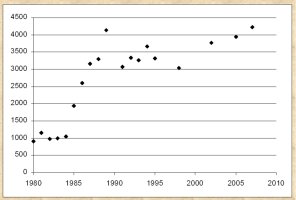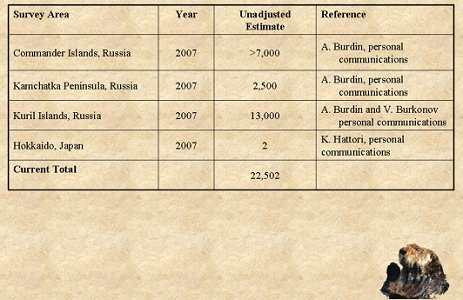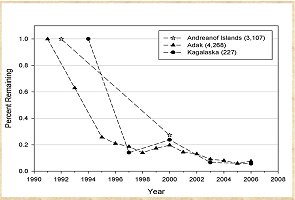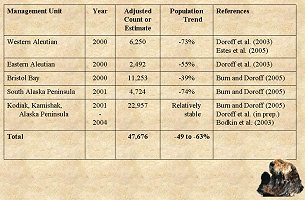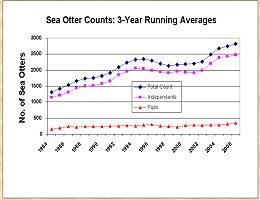IUCN/SSC Otter Specialist Group Bulletin

|
©IUCN/SCC Otter Specialist Group Volume 28A Proceedings Xth International Otter Colloquium, Hwacheon, South Korea Citation: Doroff, A.M, Hatfield, B., Burdin, A., Nichol, L., Hattoris, K. and Burkanov, V. (2011) Status Review: Sea Otter (Enhydra lutris) Population Status and Trend. Proceedings of Xth International Otter Colloquium, IUCN Otter Spec. Group Bull. 28A: 22 - 30 Status Review: Sea Otter (Enhydra lutris) Population Status and Trend Angela. M. Doroff1, Brian Hatfield2, Alexander Burdin3, Linda Nichol4, Kaoru Hattori5 and Vladimir Burkanov6
1
Marine Mammals Management, U.S. Fish and Wildlife Service, 1011 E. Tudor Road, Anchorage, AK 99503, USA
E-mail: angela_doroff@fws.gov
|
||
|
|
Abstract: The sea otter population information usually present is primarily based on counts of relative abundance with the exception of a few areas in Alaska where survey specific correction factors are determined and applied to the total count. Because of the vagaries of survey methods, survey platforms (shore-based, ship-based, and land-based sea otter counts), and habitat types, it would be inappropriate to combine all surveys over time into a global trend. Therefore it is relevant to discuss specific regions that have applied similar methods to the surveys for sea otters over time. |
| Keywords: sea otter, distribution, population status |
| Française | Español |
INTRODUCTION
The sea otter (Enhydra lutris) separated from the primitive lutrine carnivores during the upper Miocene (Berta and Morgan 1985). Sea otters are among the smallest of the marine mammals and many aspects of their morphology and physiology are unique among the lutrines but similar to seals and sea lions, reflecting their adaptation to the marine environment (Murphy et al., 1990, Newby 1975, Riedman and Estes 1990). Sea otters were hunted to near extinction for their fur until protected under the International Fur Seal Treaty in 1911 (Kenyon 1969). By then, only small colonies remained in remote areas of Russia, United States, and Canada (Figure 1). During the 1970s, the sea otter population had rapidly recolonized much of their former habitat. In the United States and Canada, the sea otter population range expansion was assisted by several translocation efforts in the mid and late 1960s conducted collaboratively by Federal and State agencies. With the passage of the Marine Mammal Protection Act (1972) sea otters were further protected from harvest and harassment in the United States. Currently, there are 3 subspecies of sea otters recognized, E. l. lutris (distribution: Kamchatka Peninsula, Kuril and Commander islands, Russia) (Linnaeus 1758:45, Wilson et al., 1991), E. l. kenyoni (distribution: the Washington translocated population westward to the Aleutian Islands in Alaska, USA and including the translocated population in British Columbia, Canada) (Wilson et al., 1991), and E. l. nereis (California, USA) (Merriam 1904:159, Wilson et al., 1991). Conservation issues for the species range-wide include the following, vulnerability to oil pollutants, poaching, conflicts with fisheries, disease, and predation. Sea otters are a sensitive indicator for the health of the near shore marine ecosystem throughout their range. Enhydra lutris is currently listed as endangered in the IUCN Red Book.
 |
|
Figure 1.
Historic and present world population distribution of sea otters (Enhydra lutris) as taken from Kenyon, 1969. (click for larger version) |
The sea otter population information we present is primarily based on counts of relative abundance with the exception of a few areas in Alaska where survey specific correction factors are determined and applied to the total count. Because of the vagaries of survey methods, survey platforms (shore-based, ship-based, and land-based sea otter counts), and habitat types, it would be inappropriate to combine all surveys over time into a global trend. It is relevant, however, to discuss specific regions that have applied similar methods to the surveys for sea otters over time. In the following sections, we discuss available sea otter population data and infer trends in relative abundance.
RUSSIA AND JAPAN
The northern sea otter population in Russia (E. l. lutris) recovered from 3 remnant populations located in the Commander Islands, the Kamchatka Peninsula, and the Kuril Islands (Figure 1). The population on the Commander Islands has been surveyed since the 1980s and is believed to be at equilibrium density (Figure 2). Surveys in 2007 indicate the highest sea otter counts obtained for this region. Along the Kamchatka Peninsula distribution is limited by winter sea ice in the northern regions and the majority of sea otters are concentrated along the southern portion of the Peninsula. In the northern Kuril Islands, sea otter counts have declined since 2003 and the 2005 population estimate was 7,500. The central Kuril Islands are believed to be at equilibrium density, however, there is likely population range expansion occurring in the southern part of the archipelago. Population surveys of the Peninsula and the Kuril Islands have been less frequent than the Commander Islands and the population trend in these areas are less well understood. The current sea otter population estimate in Russia is about 22,500 (Table 1). The sea otters observed along eastern Hokkaido, Japan, are most likely animals that have moved from the southern Kuril Islands (Hattori et al., 2005). It is also likely that the population range expansion will continue and some conflicts with the local shellfishery industry will occur (Hattori et al., 2005).
UNITED STATES
Alaska
For northern sea otters in Alaska, there are currently 3 population stocks identified (Figure 3). Population stocks were defined based on geographical differences in genetic or morphological data among regions (Gorbics and Bodkin 2005). The southwest and south-central stocks contained remnant sea otter colonies at the close of the fur trades; the southeast stock was established by the translocation of sea otters from the Aleutian Islands and Prince William Sound in the mid 1960s. The current population estimates for the southwest, south-central, and southeast stocks are 47,676, 15,090, and 10,563 respectively. The northern sea otter population in Alaska is approximately 73,329. More information on the status of sea otters can be found at: http://alaska.fws.gov/fisheries/mmm/seaotters/reports.htm
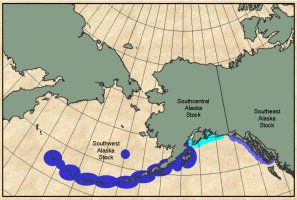 |
| Figure 3. Current population stock structure of northern sea otters (Enhydra lutris kenyoni) in Alaska, USA. (click for larger version) |
Alaska -Southwest Population Stock
The southwest population stock contained 6 remnant colonies of sea otters at the close of the fur trades in 1911. The sea otter population in this region recolonized much of its former habitat by 1994. However, during the late 1980s the population in the Aleutian Island chain began to decrease rapidly and an estimated 65,000 sea otters were lost from the population by 2000 (Doroff et al., 2003, Burn et al., 2003). All island groups in the Aleutians retained low densities of sea otters (Doroff et al., 2003, Estes et al., 2005). Figure 4 illustrates a typical pattern of population decline for the central region of the Aleutian Island chain from 1990 – 2006; modeling suggests the number of sea otters began to decline in the late 1980s. The decline in sea otter abundance was not uniform throughout the entire stock, however. Table 2 contains survey data from 2000-2004 and the percent change in counts from the last comparable survey of each region (time between surveys was variable among locations and ranged 6-15yrs). Sea otter population counts remained relatively stable for the eastern portion of the stock in the Kodiak Island region. In 2005, the entire stock was listed as Threatened under the Endangered Species Act.
Alaska -Southcentral Population Stock
At the close of the fur trades in 1911, a small remnant colony of sea otters remained in the southwestern portion of Prince William Sound. The Prince William Sound region has been surveyed regularly since the 1989 Exxon Valdez oil spill; this region contains the highest counts of sea otter in the south-central population stock (Table 3). The most recent abundance estimate for the entire Sound is 11,989 sea otters and the population trend in this region appears to be relatively stable (Bodkin et al., 2003).
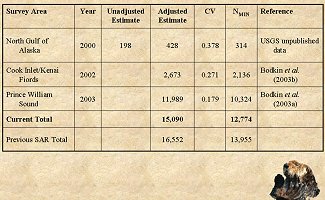 |
| Table 3. Sea otter (Enhydra lutris kenyoni) population abundance estimates in the Southcentral population stock in Alaska, USA 2000-2004. (click for larger version) |
Alaska -Southeast Population Stock
At the close of the fur trades in 1911, there were no sea otters remaining in southeast Alaska. From 1965 to 1969, 412 otters from the Aleutian archipelago and Prince William Sound were translocated to 6 sites in southeast Alaska (Jameson et al., 1982). The current population estimate for Southeast Alaska is 10,563 sea otters with the highest counts concentrated in the southern end of the stock boundary (Table 4). There has been no indication of an increase in abundance in this region; however, data are not sufficient to examine population trend. Population range expansion has occurred since the 1980s.
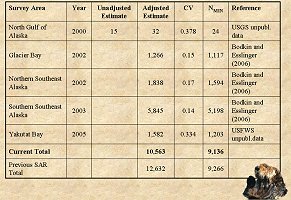 |
| Table 4. Sea otter (Enhydra lutris kenyoni) population abundance estimates in the Southeastern population stock in Alaska, USA 2000-2004. (click for larger version) |
CANADA
Sea otters were re-introduced to British Columbia from Alaska between 1969 and 1972. The first population count was made in 1977. Since 1988, field surveys have been undertaken using small boat or helicopter to determine sea otter population abundance and trends in British Columbia. A minimum population estimate is 3,185 sea otters (based on surveys conducted during 2001-2004) and the population is centered along the west coast of Vancouver Island. The population trend has been increasing in Canada but has slowed from 18.6% per year during 1977-1995 to 15.6% during 1977-2004 along the Vancouver Island coast. On the central B.C. coast, sea otter population growth averaged 12.4% per year between 1990 and 2004. As of 1996, the current population has been listed as Threatened in Canada. The Committee on the Status of Endangered Wildlife in Canada (COSEWIC) has reviewed a new assessment of the species status and has recommended that the status be changed to Special Concern. More information on the status of sea otters can be found at: http://www.sararegistry.gc.ca (search sea otter).
UNITED STATES
Washington State
A sea otter population was re-established by a translocation of sea otters from the Aleutian Islands in 1969-70. The current population is afforded protection under the Marine Mammal Protection Act (1972) and is listed as endangered by the State of Washington. In 2006, the maximum count was 790 sea otters within the sea otter range along coastal Washington. The survey results indicate an annual rate of increase of 8% since 1989. Further range expansion for this population is likely in the future.
California
In California, E. l. nereis is listed under the Endangered Species Act (ESA) and is still limited in the scope of its geographic range. The sea otter population has been counted each spring and fall since 1983. A 3-year average of the spring surveys is used to indicate population trend (Figure 5). The population declined in the mid- to late 1990s but has since had a modest increasing trend. The spring 2007 count yielded a total of 3,026 sea otters along the California mainland coast. There is an additional smaller translocated population of sea otters at San Nicolas Island (approximately 15 animals), which after many years of exhibiting no population growth has recently had counts of about 40 animals (Hatfield 2005). The number of beach-cast carcasses and live strandings recovered continues to increase and is currently about 270 otters/year over the past 4 years. Disease continues to be a high source of mortality and mortality resulting from shark bites has been elevated since 1998 (and currently accounts for approximately 15% of the total strandings).
DISCUSSION
The sea otter has recovered remarkably well from near extinction. The removal of hunting pressure by humans and strategic translocations of sea otters from southwest and south-central Alaska populations to southeast Alaska, BC Canada, and Washington have aided population recovery. However, even with these safe guards, new challenges face sea otters as a whole. Because of their role as a keystone species in the near-shore marine environment, sea otters are subject to environmental stressors to the ecological system. Shifts in ecosystem structure, such as increased predation by killer whales, have dramatically reduced the numbers of sea otters in the Aleutian Islands in southwest Alaska where the largest population occurs. The southern sea otter population in California, though only 2% of the world population, has been studied extensively (studies of free-ranging live animals and natural mortality) and provided mechanisms for multiple stressors related to food limitation, disease, and predation on the population. In the future, we predict warming ocean temperatures, an increase in ocean acidification, and shifts in geographic ranges for marine species, all of which will influence the near-shore marine ecosystem and the world’s sea otter population.
REFERENCES
Berta, A., G.S. Morgan. (1986). A new sea otter (Carnivora: Mustelidae) from the late Miocene and early Pliocene (Hemphillian) of North America. J. Paleo. 59: 809-819.
Bodkin, J.L., Ballachey, B.E., Dean, T.A., Esler, D. (2003). Patterns and Processes of Population Change in Selected Nearshore Vertebrate Predators. Exxon Valdez Restoration Project //423. Final Report. 83pp.
Burn, D.M., Doroff, A.M., Tinker. M.T. (2003). Estimated carrying capacity and pre-decline abundance of sea otters (Enhydra lutris kenyoni) in the Aleutian Islands. Northwestern Naturalist. 84: 145-148.
Doroff, A.M., Estes, J.A., Tinker, M.T., Burn, D.M., T.J. Evans. (2003). Sea otter population declines in the Aleutian Archipelago. J. Mammal. 84: 55-64.
Estes, J.A., Tinker, M.T., Doroff, A.M., Burn. D.M. (2005). Continuing sea otter population declines in the Aleutian archipelago. Marine Mammal Science 21: 169-172.
Gorbics, C. S., Bodkin, J.L. (2001). Stock structure of sea otters (Enhydra lutris kenyoni ) in Alaska. Marine Mammal Science 17: 632-647.
Hatfield, B.B. (2005). The translocation of sea otters to San Nicolas Island: an update. pp. 473-475. In:Garcelon D.K., Schwemm, C.A. (eds.) Proceedings of the 6th California islands symposium. National Park Service Technical Publication CHIS-05-01, Institute for Wildlife Studies, Arcata, California.
Hattori, K., Kawabe, I., Mizuno, A.W., Ohtaishi, N. (2005). History and status of sea otters, Enhydra lutris along the coast of Hokkaido, Japan. Mammalogical Society of Japan, Mammal Study 30: 41-51.
Jameson, R.J., Kenyon, K.W., Johnson, A.M., Wight, H.M. (1982). History and status of translocated sea otter populations in North America. Wildl,. Soc. Bull. 10: 100-107.
Kenyon, K.W. (1969). The sea otter in the eastern Pacific Ocean. North American Fauna 68. U.S. Department of the Interior, Washington D.C.
Linnaeus, C. (1758). Systemma naturae. 10th ed. L. Salvii, Uppsala 823pp.
Merriam, C.H. (1904). A new sea otter from southern California. Proc. Biol. Soc. Washington. 17: 159-160.
Murphy, C.J., Bellhorn, R., Williams, T., Burns, M., Schaeffel, F., Howland. H. (1990). Refractive state, ocular anatomy, and accommodative range of the sea otter (Enhydra lutris). Vision Res. 30: 23-32.
Newby, T.C. (1975). A sea otter (Enhydra lutris) food dive record. Murrelet 56: 19.
Riedman, M.L., Estes, J.A. (1990). The sea otter Enhydra lutris: behavior, ecology, and natural history. Biological Report; 90 (14). U.S. Fish and Wildlife Service.
Wilson, D.E., Goan, M.A., Brownell, R.L. Jr., Burdin, A.M., Maminov, M.K. (1991). Geographic variation in sea otters (Enhydra lutris). J. Mammal. 72: 22-36.
Résumé : Bilan des Coinnaissances sur les Populations de Loutre de Mer (Enhydra lutris) et Tendances
Les informations présentées sur la population de loutres de mer sont généralement basées sur les chiffres d’abondance relative à l'exception de quelques zones en Alaska où des facteurs de correction spécifiques sont déterminés et appliqués pour évaluer l’effectif total. Étant donné la variabilité des méthodes, les points d’observations (à terre, à partir de navires et le dénombrement à terre) et les types d'habitat, il serait inapproprié de regrouper toutes les enquêtes actuelles et passées afin d’apprécier une tendance globale. Par conséquent, il est plus pertinent de discuter de résultats propres à certaines régions qui ont appliqué des méthodes communes.
Revenez au dessus
Resumen: Revisión de la Situación: Nutria Marina (Enhydra lutris) Estado y Tendencias de la Poblacion
Datos sobre población de nutria marina son presentados normalmente con base en cuentas de abundancia relativa. En algunas areas en Alaska, excepcionalmente, se determinan factores de correction relacionados a los metodos de seguimiento que son utilizados para corregir la cuenta total. Debido a las variaciones en los métodos de studio, en los puntos de observación (cuentas basadas en observacion desde la rivera, en bote o en tierra firme) y en los tipos de hábitat, sería inapropiado simplemente mezclar los resultados proveniendes de diversos estudios para producir tendencias temporales y/o globales. Por lo tanto, es pertinente discutir regiones específicas que han aplicado metodos de estuio similares al seguimiento de nutrias marinas en el tiempo.
Vuelva a la tapa






